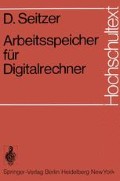Zusammenfassung
Magnetspeicher verdanken ihre Entstehung dem Wunsch, die Zugriffsbzw. Zykluszeit weiter herabzusetzen als das beim Ferritkernspeicher möglich ist. Jenem sind Grenzen gesetzt durch die Schaltzeit der Kerne, durch die Induktivitäten der Treibleitungen und die Erwärmung der Kerne bei schneller Wiederholung des Lesens und Schreibens. Magnetschichten bieten demgegenüber den Vorteil vernachlässigbarer Schaltzeiten, vernachlässigbarer Umschaltverluste, und im Fall des flachen Schichtspeichers auch des definierten Wellenwiderstandes der Treibleitungen. Von der Zwischenlösung der aus ferromagnetischen Bändern gewickelten Bandringkerne ist man wegen der Herstellungsschwierigkeiten und der bei beherrschbarer Herstellungsdicke von einigen Mikrometern noch merkbaren Wirbelströme wieder abgekommen.
Access this chapter
Tax calculation will be finalised at checkout
Purchases are for personal use only
Preview
Unable to display preview. Download preview PDF.
Schrifttum zu Abschnitt 3
Werner, G.E., et al.: A 110-nanosecond ferrite core memory. IBM J. Res. and Dev. 11 (1967) 2, 153–161.
Pugh, E.W.; Shalan, V.T.; Siegle, W.T.: Device and array design for a 120 nsec magnetic film main memory. IBM J. Res. and Dev. 11 (1967) 2, 169.
Kohn, G.; Jutzi, W.; Mohr, Th.; Seitzer, D.: A very-high-speed nondestructive-read magnetic film memory. IBM Res. and Dev. 11 (1967) 2, 162.
Anacker, W.; Bland, G.F.; Pleshko, P.; Stuckert, P.E.: On the design and performance of a small 60 nsec destructive readout magnetic film memory. IBM J. Res. and Dev. 10 (1966) 1, 41–50.
Bobeck, A.H.: Properties and device applications of magnetic domains. Bell Syst. Techn. J. 46, II (1967) 8, 1901.
Smith, D.O.: Magnetization reversal in thin films. J. Appl. Phys. 29 (1958) 3, 264.
Feldtkeller, E.: Eine anschauliche Darstellung der kohärenten Magnetisierungsdrehung in dünnen ferromagnetischen Schichten. Z. Angew. Phys. (1960) 12, 257.
Dietrich, W.; Pröbster, W.E.; Wolf, P.: Nanosecond switching in thin magnetic films. IBM J. Res. and. Dev. 4 (1960) 189–196.
Middelhoek, S.; Wild, D.: Review of wall creeping in thin magnetic films. IBM J. Res. and Dev. 11 (1967) 1, 93–105.
Stein, K.U.; Feldtkeller, E.: Wall streaming in ferromagnetic thin films. J. Appl. Phys. 38 (1967) 4401–4408.
Kayser, W.: Übersicht über Speicherverfahren für Speicher mit dünnen magnetischen Schichten. Elektron. Rechenanl. 4 (1962) 2, 60.
Billing, H.: Magnetische Stufenschichten als Speicherelemente. Elektron. Rechenanl. 5 (1963) 257–261.
Jutzi, W.: Das magnetische Feld einer unsymmetrischen Parallelbandleitung mit magnetischem Rückverschluß. Arch. elektr. Übertrag. 21 (1967) 4, 190–197.
Jutzi, W.: Das magnetische Impulsfeld einer unsymmetrischen Parallelbandleitung. Arch. elektr. Übertrag. 19 (1965) 119–125.
Seitzer, D.: Amplifier and driver circuits for thin film memories with 12 nsec read cycle time. IEEE Trans. EC 13 (1964) 6, 722–729.
Seitzer, D.: Eine Gabelschaltung für Nanosekundenimpulse zur Herabsetzung der Schreibstörung in einem Magnetschichtspeicher. Arch. elektr. Übertrag. 18 (1964) 10, 577–584.
Bland, G.F.: Directional coupling and its use for memory noise reduction. IBM J. Res. and Dev. 7 (1963) 3, 252–256.
Stein, K.U.: Grenzen der Geschwindigkeit und Kapazität bei Magnetspeichern. Elektron. Rechenanl. 11 (1969) 2, 65.
Hsu Chang: Coupling sets thin magnetic films on closed flux path. IEEE Trans. MAG 6 (1970) 4, 774.
Hsu Chang; Mazzeo, N.J.; Romankiw, L.T.: 0,25 × 106 bit/in2 NDRO coupled film memory elements. IEEE Trans. MAG 6 (1970) 4, 774.
Jutzi, W.: Very high-speed cross-sectional model for a 147-kbit thin magnetic film memory in the NDRO mode. IEEE Trans. MAG 3 (1967) 4, 640.
Fedde, G.A.: Plated wire: a long shot that’s paying off. Electronics 41 (1963) 11, 124.
Meier, D.A.: Rods look likes wires, act like cores. Electronics 41 (1968) 11, 128.
Bobeck, A.H.: A new storage element suitable for large sized memory arrays — the Twistor. Bell Syst. Techn. J. 36 (1957) 1319–1340.
Aschmoneit, E.K.: Twistor-Speicher großer Kapazität. Elektronik 12 (1963) 9, 257–262.
Author information
Authors and Affiliations
Rights and permissions
Copyright information
© 1975 Springer-Verlag. Berlin/Heidelberg
About this chapter
Cite this chapter
Seitzer, D. (1975). Magnetschichtspeicher. In: Arbeitsspeicher für Digitalrechner. Hochschultext. Springer, Berlin, Heidelberg. https://doi.org/10.1007/978-3-642-80868-5_3
Download citation
DOI: https://doi.org/10.1007/978-3-642-80868-5_3
Publisher Name: Springer, Berlin, Heidelberg
Print ISBN: 978-3-540-06928-7
Online ISBN: 978-3-642-80868-5
eBook Packages: Springer Book Archive

